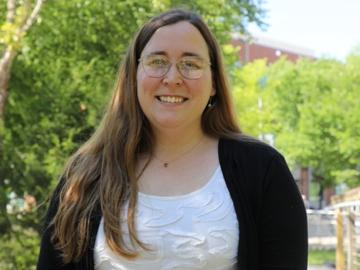
Filter News
Area of Research
- Advanced Manufacturing (13)
- Biology and Environment (29)
- Building Technologies (1)
- Computational Engineering (2)
- Computer Science (7)
- Electricity and Smart Grid (1)
- Energy Science (71)
- Fusion Energy (1)
- Isotopes (1)
- Materials (27)
- Materials for Computing (8)
- Mathematics (1)
- National Security (9)
- Neutron Science (4)
- Quantum information Science (3)
- Sensors and Controls (1)
- Supercomputing (16)
News Type
News Topics
- (-) 3-D Printing/Advanced Manufacturing (47)
- (-) Big Data (29)
- (-) Clean Water (21)
- (-) Grid (29)
- (-) Machine Learning (24)
- (-) Materials (45)
- (-) Polymers (15)
- (-) Quantum Science (16)
- Advanced Reactors (15)
- Artificial Intelligence (25)
- Bioenergy (40)
- Biology (48)
- Biomedical (24)
- Biotechnology (11)
- Buildings (31)
- Chemical Sciences (22)
- Composites (14)
- Computer Science (56)
- Coronavirus (17)
- Critical Materials (14)
- Cybersecurity (9)
- Emergency (1)
- Energy Storage (45)
- Environment (88)
- Exascale Computing (4)
- Fossil Energy (1)
- Frontier (4)
- Fusion (18)
- High-Performance Computing (23)
- Hydropower (8)
- Irradiation (2)
- Isotopes (18)
- ITER (4)
- Materials Science (49)
- Mathematics (8)
- Mercury (7)
- Microscopy (22)
- Molten Salt (5)
- Nanotechnology (18)
- National Security (20)
- Neutron Science (37)
- Nuclear Energy (35)
- Partnerships (4)
- Physics (20)
- Quantum Computing (6)
- Security (8)
- Simulation (17)
- Space Exploration (10)
- Statistics (1)
- Summit (10)
- Transportation (48)
Media Contacts

Chad Parish, a senior researcher at ORNL, studies materials at the atomic level to improve nuclear reactors. His work focuses on fusion and fission energy, using microscopy and collaborating with experts to advance materials for extreme environments.

From during his early years at NASA to his current role a researcher and group leader, Peter Fuhr has pushed the boundaries of optical and sensor technology. Fuhr’s path is marked by wacky creativity that can’t confine itself to challenges in a single field. No idea is too far out to try out — and so many of them work that Fuhr has a host of inventions and start-ups under his belt.

Researchers have identified a molecule essential for the microbial conversion of inorganic mercury into the neurotoxin methylmercury, moving closer to blocking the dangerous pollutant before it forms.

Huan Zhao, a Eugene P. Wiger Fellow at ORNL, focuses on advancing quantum materials and information technologies, inspired by his grandfather's passion for education. His research in energy-efficient memory devices and sensitive quantum light sources reflects his commitment to scientific progress and education equity.

Oak Ridge National Laboratory researchers are using a new bioderived material to 3D print custom roosting structures for endangered bats.

Researchers have developed and 3D printed the lightest crack-free alloy capable of operating without melting at temperatures above 2,400 degrees Fahrenheit, which could enable additively manufactured turbine blades to better handle extreme temperatures, reducing the carbon footprint of gas turbine engines such as those used in airplanes.

The Advanced Plant Phenotyping Laboratory at ORNL utilizes robotics, multi-modal imaging, and AI to enhance understanding of plant genetics and interactions with microbes. It aims to connect genes to traits for advancements in bioenergy, agriculture, and climate resilience. Senior scientist Larry York highlights the lab's capabilities and the insights from a new digital underground imaging system to improve biomass feedstocks for bioenergy and carbon storage.

Karly Harrod, recipient of the Early Career Competition Laboratory Directed Research and Development award at ORNL, is focused on extracting disease data from reports. Passionate about global health, she looks forward to applying her expertise to climate data within the geospatial science and human security division.

Daryl Yang is coupling his science and engineering expertise to devise new ways to measure significant changes going on in the Arctic, a region that’s warming nearly four times faster than other parts of the planet. The remote sensing technologies and modeling tools he develops and leverages for the Next-Generation Ecosystem Experiments in the Arctic project, or NGEE Arctic, help improve models of the ecosystem to better inform decision-making as the landscape changes.

Distinguished materials scientist Takeshi Egami has spent his career revealing the complex atomic structure of metallic glass and other liquids — sometimes sharing theories with initially resistant minds in the scientific community.


